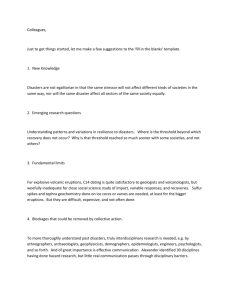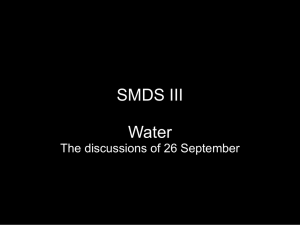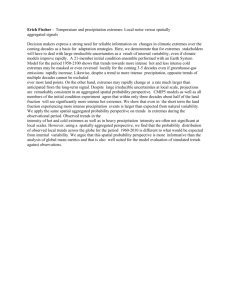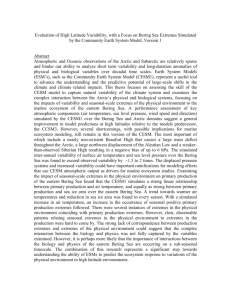Tool for Risk Management related to Climate Change
advertisement
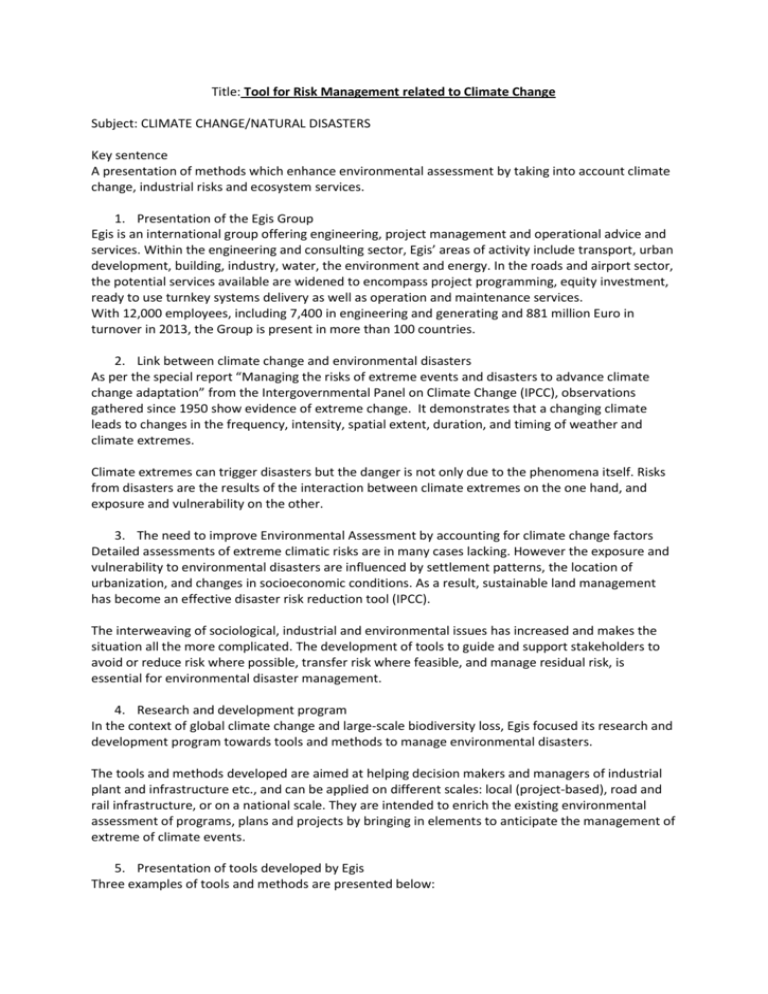
Title: Tool for Risk Management related to Climate Change Subject: CLIMATE CHANGE/NATURAL DISASTERS Key sentence A presentation of methods which enhance environmental assessment by taking into account climate change, industrial risks and ecosystem services. 1. Presentation of the Egis Group Egis is an international group offering engineering, project management and operational advice and services. Within the engineering and consulting sector, Egis’ areas of activity include transport, urban development, building, industry, water, the environment and energy. In the roads and airport sector, the potential services available are widened to encompass project programming, equity investment, ready to use turnkey systems delivery as well as operation and maintenance services. With 12,000 employees, including 7,400 in engineering and generating and 881 million Euro in turnover in 2013, the Group is present in more than 100 countries. 2. Link between climate change and environmental disasters As per the special report “Managing the risks of extreme events and disasters to advance climate change adaptation” from the Intergovernmental Panel on Climate Change (IPCC), observations gathered since 1950 show evidence of extreme change. It demonstrates that a changing climate leads to changes in the frequency, intensity, spatial extent, duration, and timing of weather and climate extremes. Climate extremes can trigger disasters but the danger is not only due to the phenomena itself. Risks from disasters are the results of the interaction between climate extremes on the one hand, and exposure and vulnerability on the other. 3. The need to improve Environmental Assessment by accounting for climate change factors Detailed assessments of extreme climatic risks are in many cases lacking. However the exposure and vulnerability to environmental disasters are influenced by settlement patterns, the location of urbanization, and changes in socioeconomic conditions. As a result, sustainable land management has become an effective disaster risk reduction tool (IPCC). The interweaving of sociological, industrial and environmental issues has increased and makes the situation all the more complicated. The development of tools to guide and support stakeholders to avoid or reduce risk where possible, transfer risk where feasible, and manage residual risk, is essential for environmental disaster management. 4. Research and development program In the context of global climate change and large-scale biodiversity loss, Egis focused its research and development program towards tools and methods to manage environmental disasters. The tools and methods developed are aimed at helping decision makers and managers of industrial plant and infrastructure etc., and can be applied on different scales: local (project-based), road and rail infrastructure, or on a national scale. They are intended to enrich the existing environmental assessment of programs, plans and projects by bringing in elements to anticipate the management of extreme of climate events. 5. Presentation of tools developed by Egis Three examples of tools and methods are presented below: Tools to assist transportation, infrastructure, construction and operation companies in identifying sensitive zones at risk of natural disasters; Industrial risk assessment method including identifying extremes of climate modeling and mapping; Evaluation of ecosystem services; which intends to identify the role of natural ecosystems in preventing disasters and integrates them in the assessment process. 6. Transport, infrastructure management and climate change Currently, most of the existing transport infrastructures are not built to withstand climate extremes. Their design is generally based on past events however; a changing climate leads to changes in the frequency, intensity, spatial extent, duration, and timing of weather and climate extremes. These factors can result in unprecedented extremes. Transportation infrastructure is one of the sectors sensitive to climate extremes (IPCC). Climate change can have a direct impact on transport infrastructure: extreme rainfall causes floods, erosion, landslides and traffic disturbance; seasonal and annual rainfall can cause landslide and pavement cracking; sea level increase can lead to erosion of coastal transport infrastructures; extreme temperatures increase rutting, potholes and damage to roads, dilatation of bridges, railways, concrete structures etc., and fires; high winds can bring down signage, trees and power lines, ... Economic and human need for transport infrastructure is important and the social acceptability of risks is decreasing. It is therefore considered that knowledge of climate extremes during the design and operation phases of projects is essential. Several tools have been developed by Egis to adapt transport infrastructure design to climate extremes. GERICI (gestion des risques liés au changement climatique pour les infrastructures routières) was developed in 2007 to assess risks caused by climate change to road infrastructure and then adapting infrastructure management to it. In the same way, RESILIENCE was developed to assess risks caused by climate change to rail infrastructure. They are both suitable at the infrastructure scale only. The method for assessing risks is completed by a model detecting vulnerable areas of transport infrastructure to potential climate extremes. A geographic information system (GIS) tool then presents the risks and vulnerable areas on a map. These results are used to select not only mitigation measures and action plans to reduce risk and decrease potential impacts but also to define emergency plans. RIMAROCC (risk management for roads in a changing climate) was developed in 2010 via the ERANET European program. The purpose of this tool is also the assessment of risks caused by climate change to transport infrastructure but is also suitable on a wider transport network scale or on a landscape scale. ESPADA, a tool for the prediction and management of actual floods in urban areas, was developed to avoid human disasters when floods appear. It was developed by Egis after large-scale flooding in the south of France in 2002 and 2003 which caused the death of 22 people. 7. Climate change in an urban context A specific method for vulnerable urban areas was developed and implemented between 2009 and 2011 for three coastal towns (Alexandria / Egypt, Tunis / Tunisia and Casablanca / Morocco) in North Africa. This project, named “Adaptation au changement climatique et résilience aux désastres naturels des villes côtières d’Afrique du Nord” was funded largely by the World Bank. The method is based on several steps: Context analysis, in order to understand the potential risks; Definition of risks in order to identify and locate vulnerable areas; Risks analysis in order to define risk exposure to climate extremes; Risk assessment and estimation of potential costs. The model relating to a specific area is applied and a risk map is created. An action plan is proposed in order to adapt and increase resilience of the project; The different mitigation options are compared using a decision-making tool based on costeffectiveness studies; Finally, monitoring/audits are implemented. Results are used to improve the context analysis and improve the method at each stage. 8. Industrial safety and climate change Industrial risk assessment concerns three types of issues: risk acceptability (social issues), protection of property and the safety of people (human issues) and environmental protection (environmental issues). Different tools are used to model the impact of an industrial project on specific vectors, such as dispersion of air pollutants, atmospheric deposition on soil, etc. Egis’ tools improve this industrial risk analysis leading to more accurate results. Climate change and climate extremes in particular can influence industrial safety. Opportunities to reduce complex and combined hazards are provided by multi-hazard risk management approaches. Egis applies methods and models, including assessing potential risks of extreme climates within industrial risk assessment studies. The method aims to analyze the cumulative consequences which could affect the lives of humans and the environment, providing more efficient data to local authorities and informing their planning decisions. 9. The role of ecosystem services in preventing natural disasters As per the IPCC report, in the context of changing climate risks, ecosystem-based solutions can provide cost-effective risk reduction, assist biodiversity conservation, and improve economic livelihoods and human well-being. Ecosystem services are the benefits that people derive from the environment and from biodiversity: natural products, natural functions, social benefits and natural processes. Some ecosystem services have a direct impact on climate change management (global climate regulation, carbon capture and storage) and have a role in preventing climates extremes (i.e. role of estuaries in preventing flooding, role of mangroves in protecting coastal erosion ...). It is essential to protect the function of ecosystems in order to maintain the level of their services. Identification of these ecosystem services is crucial for their protection. Within this context, Egis applied a new approach to identifying the role of natural ecosystems in preventing disasters and is able to apply them to the assessment process. The ecosystem services tool consists of defining existing ecosystem within the study area, determining the associated ecosystem services and ranks them quantitatively. They are then mapped along with land-use, topography and weather patterns to identify “hotspots” where ecosystem services are deemed to be of high value in preventing and reducing the severity of natural disasters. Planners can use this data to modify and adapt around these considerations. 10. Conclusion Climate change factors now need to be applied to the environmental impact assessment process to protect and sustain people’s livelihoods in the face of climate extremes. Several tools have been developed by Egis which takes account of these factors. These methods are best implemented prior to the construction phase of projects and are well adapted to the concept of sustainable development.
